Choosing to shoot black and white photography is exactly that — a choice. It is a choice that many photographers choose to make when shooting portraits. Why? What is it about a black and white photo that works so well when capturing the face of a person? How can you use black and white photography to create striking portraits that convey both meaning and emotion?
Let’s take a look at the process of shooting black and white portrait photography and some tips that will help you achieve powerful portraits.
Shooting black and white portrait photography
Choose digital or film
The very first thing you must determine when shooting any photograph is whether you will shoot digital or film. Both have their benefits and both have their downsides.
Film obviously provides a unique look and style. It can entail elements like the texture of film grain and change how you compose photos. This is especially true when shooting black and white photos that aim for a classic style reminiscent of older photographs.
Platon Antoniou, arguably one of the best portrait photographers working today, chooses to shoot on film because it keeps him connected with his subjects. Take a look at Platon in action and the influence of film on his work.
Platon: Black and white portrait photography
Digital photography, on the other hand, may lack the classic elements of film. However, they make up for it in their flexibility. Shooting with DSLR cameras or mirrorless cameras will enable you to shoot in RAW file format. This retains all image information, giving you flexibility to tweak and manipulate the image in a way that you could not otherwise.
Digital black and white photos can also capture a cleaner, more modern portrait style. Determining whether you will shoot film or digital will depend entirely on the portraiture style you envision.
Black and white portrait photos tips
Shoot for black and white
Before you shoot a black and white portrait, it is important to understand why you are shooting in black and white. How does black and white make this portrait better than if it was taken in color?
It is important to keep in mind that your portrait will be black and white from the very beginning. Lighting, composition, and camera settings will change once you decide to shoot black and white. Many photographers wonder if they should shoot in black and white in-camera or shoot in color and convert to black and white in post.
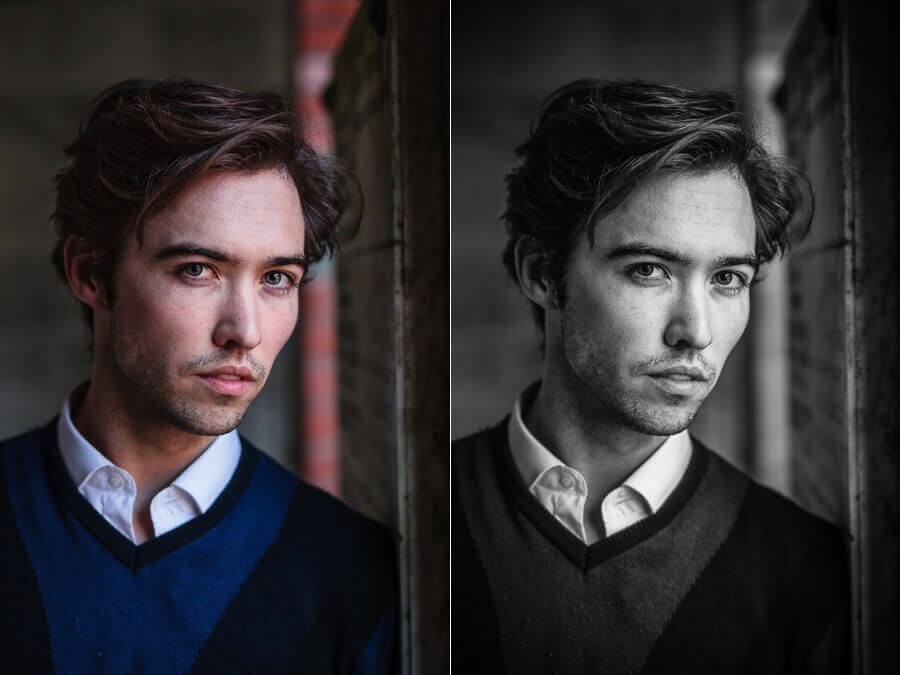
Color to B&W portrait
If you are shooting RAW, this decision does not matter as much since RAW will allow you to change from monochromatic to color or vice versa in editing. Shooting in-camera, black and white, and in RAW will allow you to see the image you shoot immediately in black and white as you shoot. But it will also give you the ability to convert to color if need be.
Black and white portrait photography settings
Select your camera settings
Many photographers are drawn to black and white photography because of its use of contrast. When it comes to portraits, this contrast can draw emphasis to a subject and create a powerful image. Your settings should complement the visual style you are trying to achieve.
Using a larger aperture like f/1.4 or f/2.8 will create a shallow depth of field. The shallow depth of field will put any distractions out of focus and draw more attention to your subject.
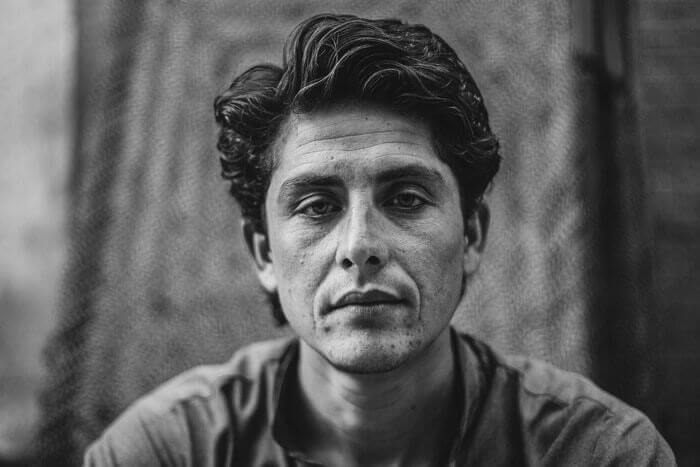
Best black and white portraits examples
This will also create some separation between your subject and their background which is great for portraiture. To learn more about the relationship between aperture and depth of field, check out our complete aperture video breakdown.
B&W portrait aperture settings • Subscribe on YouTube
Another component of the exposure triangle to consider experimenting with is ISO. Traditionally, film photos contain image grain which can add texture to a portrait. To achieve this digitally, create an appropriate amount of image noise by using a higher ISO.
This well emulates the textural effect of film grain. Check out how ISO can be used stylistically to create noise in this ISO video breakdown.
Black and white portrait photos ISO • Subscribe on YouTube
However, if you wish to produce a high resolution portrait with minimal noise, opt for an ISO value close to your camera’s native ISO. This will give you the most dynamic range. Of course, your camera settings will also be influenced by your lighting set up.
Black and white portrait photography lighting
Experiment with lighting
As we mentioned earlier, the allure of black and white portrait photography lies in its use of contrast. If this is why you too want to shoot a portrait in black and white, do not be afraid to experiment with different lighting techniques.
Using a single light source can create a tremendous amount of drama in a photograph. The high contrast of split lighting matches the style of black and white. For example, a split lighting setup can make your subject look mysterious or enigmatic.

Black and white portrait photography • Split Lighting Setup
If you want just a bit more detail from your subjects but still want dramatic lighting, experiment with Rembrandt lighting. The use of shadow and highlights in Rembrandt lighting works extremely well with black and white photography.
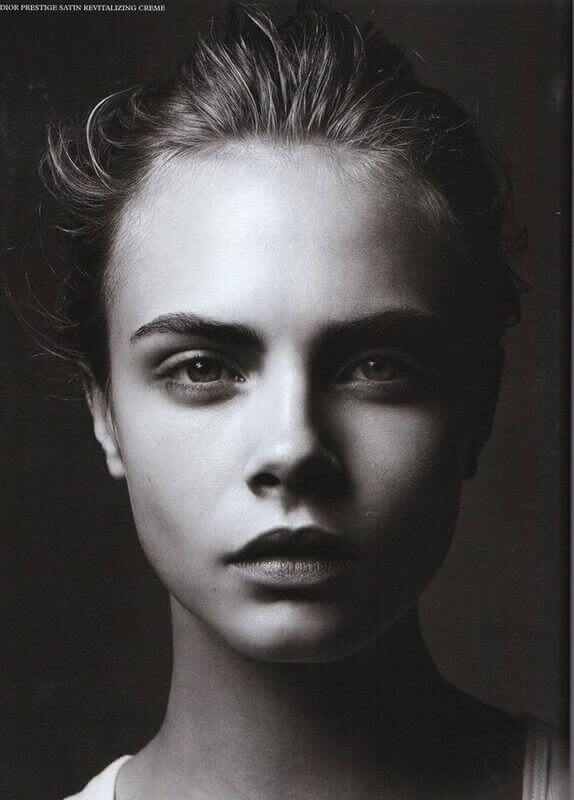
Rembrandt Lighting for black and white portrait photos
Chiaroscuro lighting is one of the key black and white portrait techniques that emphasizes the juxtaposition of light and darkness. It’s use of low and high-contrast lighting helps establish the mood of your black and white portrait.
These are only a few types of lighting setups that work well with black and white photography. The goal in mind is to find lighting styles that complement the strengths of black and white which is contrast.
This video tutorial on black and white portraiture with one light will help give you lighting ideas to get the ball rolling.
How to light a B&W portrait with one light
Beyond specific lighting setups and styles, be sure to get creative with how you utilize shadows. Casting shadows on your subject can add another layer of meaning to your powerful black and white portraits.
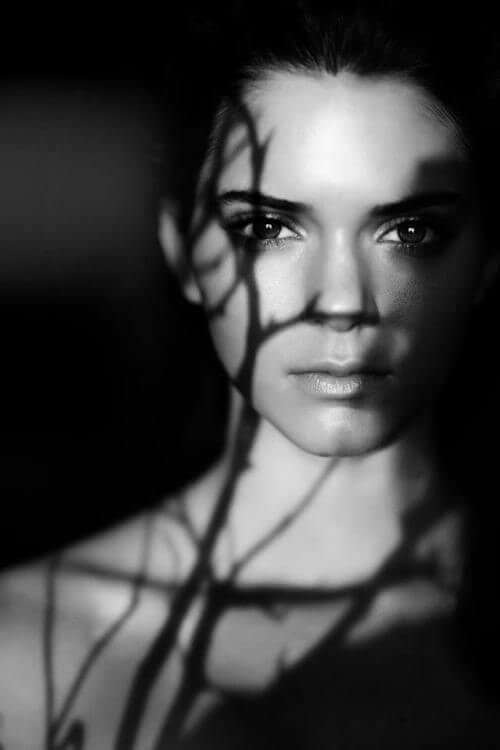
Shadows in black and white portrait photos
Finding the right type of lighting setup for your portrait will take trial and error and a lot of practice. A dramatic, mysterious split lighting setup may work well for one subject, but not so much for another. Be flexible yet intentional with your lighting setups to create powerful black and white portraits.
B&W portrait posing tips
Pose your subjects
A huge part of being a portrait photographer is posing your subject. While this is true of both color and black and white portraits, there are a few things to keep in mind when shooting black and white specifically.
Eyes are priority
In black and white photography, the eyes are more important than ever. Eyes tend to pop in a black and white photography portrait. So try to pose your subject in a way that allows their eyes to really tell a story. This often means telling your subject to look right into the lens as you get in close.
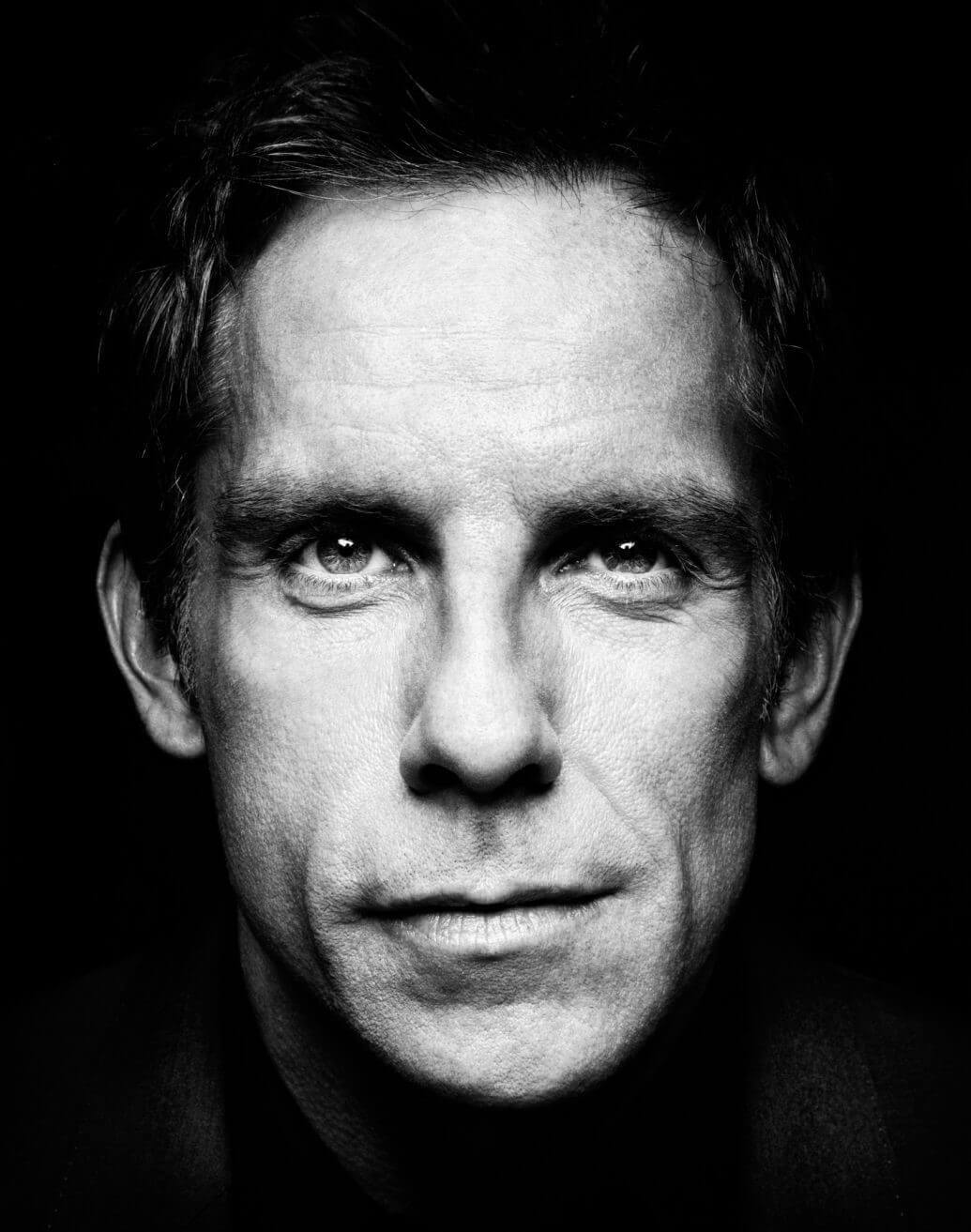
Best black and white portraits by Platon
Find and create shapes
A common practice in shooting a black and white photography portrait is shooting against an all white background. If you plan to do this, keep in mind that the contrast of subjects against this blank background will draw an emphasis to shapes.
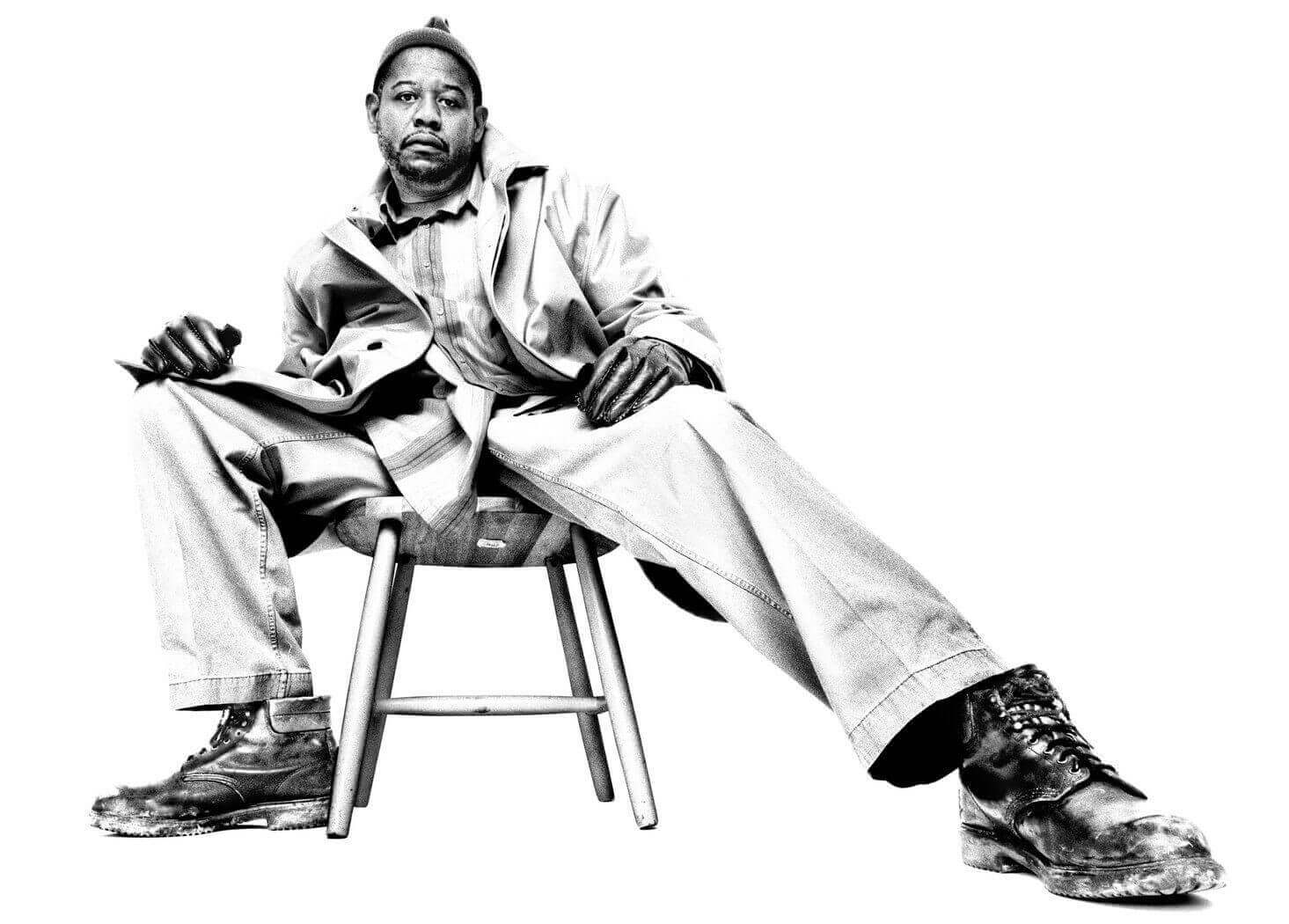
Best black and white portraits by Platon
Because of this, posing your subject to create pleasing compositional shapes is important and a key to unique, striking portraits. As you can see from the portrait of Forest Whitaker above, Platon is one of the masters of this. He utilizes his ability to pose his subjects to create shapes that pop and match the story of who he is shooting.
How to do black and white portrait photography
Utilize negative space
Black and white is minimalist in nature. Its lack of color can bring simplicity to an otherwise, complex or convoluted photograph. Feel free to lean into this simplicity in your portraits by utilizing negative space.
Shadows tend to bleed into other shadows and highlights tend to bleed into other highlights to create negative spaces in an image. Creating compositions that utilize this effect can create powerful portraits.
For example, take a look at this portrait by photographer Lee Jeffries. Notice how the subject’s clothing bleeds into the black background creating a seamlessness that draws further focus to their face and arms.
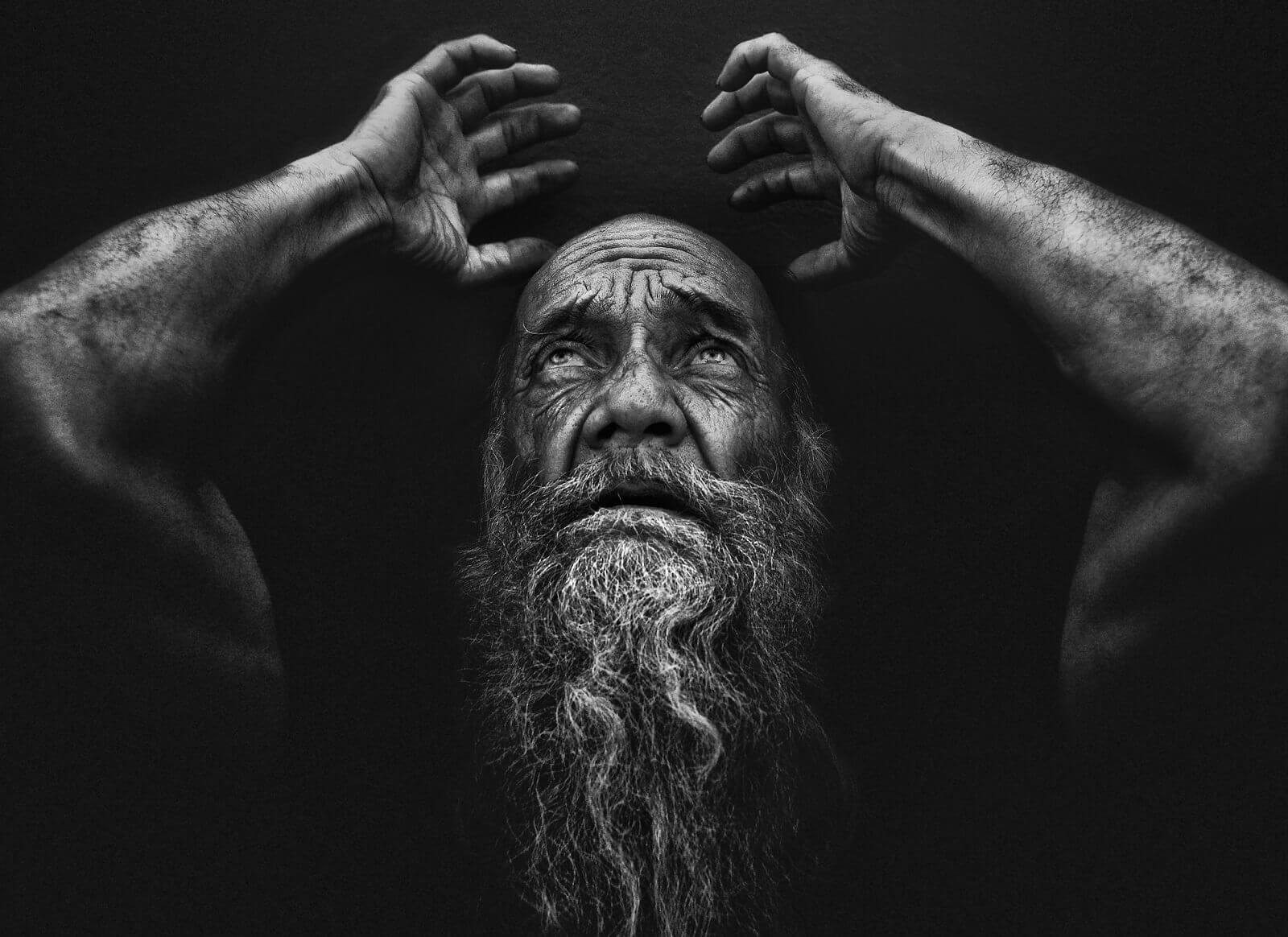
Best black and white portraits by Platon
Even if you are not shooting in a controlled studio, shooting against solid backgrounds like a clear sky or blank wall will allow you to tweak the background in editing and achieve a similar effect.
Editing black and white portrait photography
Editing black and white portraits
Editing a black and white photography portrait is more than simply adjusting contrast, shadows, and highlights. Believe it or not, color matters when editing black and white photos. Sure you may not be able to see the colors, but every image is composed of red, green, and blue.
Altering some of these colors will create different effects in your black and white portrait photography. To learn how to adjust these elements in Photoshop, check out this video tutorial by Phlearn.
How to Create a Stunning Black and White Photo
Another great tip for editing a black and white photo is to utilize calculations. Don’t worry, this won’t require any use of calculus. This simply means utilizing the “Calculations” tool in Photoshop to blend different channels from the same image. This allows you to manipulate more details and get more variation from a black and white photo.
Check out this comprehensive Photoshop tutorial on how to utilize calculations and color channels to edit your black and white portrait photography.
Black and white portrait photos Using Calculations in Photoshop
When shooting black and white portraits it is important to remember that by lacking color, black and white photos draw attention to other elements like contrast, shapes, and space. Utilizing these elements through lighting, posing, and editing will help you create striking black and white portraits.
UP NEXT
Chiaroscuro lighting and its effects
Black and white photography is defined by its use of shadows and light. If this is what allures you to shooting black and white, then learning about Chiaroscuro lighting styles is essential. The term derives from the Italian words “chiaro” meaning “bright,” and “oscuro” meaning “dark.” Learn more about the Chiaroscuro visual style in our next article.
Up Next: Chiaroscuro lighting →
Showcase your vision with elegant shot lists and storyboards.
Create robust and customizable shot lists. Upload images to make storyboards and slideshows.
